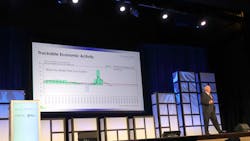Having spent almost all of 2020 under various forms of lockdown, the global economy began to regain its momentum in 2021. But by late 2021, new instability, most visible in the supply chain disruptions, was threatening further growth.
New patterns of demand, together with uncertainty in supply, brought about changes in prices that quickly coalesced into enough inflation to attract the attention of the Federal Reserve, which began to raise interest rates early in 2022.
The single-most important factor in determining the start of a recession in 2023 is how, when, and why the Federal Reserve stops raising the Target Federal Funds rate. Unless there are exigent circumstances, all announcements about monetary policy will take place at the regularly scheduled meetings of the Federal Open Market Committee (FOMC). At those meetings, the Committee examines a host of economic statistics as well as anecdotal information about business conditions to decide what the risks to stable economic states are and how to meet those risks.
The first economic statistics the FOMC gives a close reading to are the employment figures published by the Bureau of Labor Statistics, usually on the first Friday of the month. We say “close reading” because the headlines on the report are the least valuable piece of information in the report. The size and, most importantly, the composition of the change in employment is what matters.
Over the past several months, the number of people on payrolls has been increasing by about 250,000 each month, a pace consistent with an expanding economy. Because the FOMC has stated a desire to see the pace of expansion slacken, it will take a smaller number to convince them of that fact.The second report the FOMC will look at, also in minute detail, is the rate of inflation as calculated by the Bureau of Labor Statistics in the All-Items Consumer Price Index Report (CPI). The CPI is a measure of the cost of living. The year-over-year percent change in the CPI is the most widely known measure of inflation. The FOMC uses the CPI rate of inflation, together with several other indexes, to assess current and prospective price pressures in the economy. Rising inflation is a risk to economic stability. And because the FOMC is charged with protecting against risks to economic stability, it responds to changes in the level of inflation.
While we have recently seen considerable improvement in the headline rate of inflation, which has come down from 9.0% in June 2022 to 6.4% in December 2022, one might ask how quickly the CPI might go back to 2%, which is the FOMC’s target rate of inflation.
Based on what we can see in the latest report, the answer is “not soon.” While gasoline and used-car prices have abated, we still have significant pressure from the shelter and food components of the index, all of which suggests a headline rate of 5% or higher during the first half of the year.
Which brings us to the process under which the FOMC will discuss and decide what their next course of action will be.
Since 1987, it has been the practice of the FOMC to engage in an interest rate management strategy known as “pause and pivot.” Each of the episodes in which they have engaged in a campaign to slow the economy through higher interest rates has contained an interval where they held interest rates steady (the pause) before they lowered them (the pivot). Jerome H. Powell, Chair of the Board of Governors of the Federal Reserve System, has indicated that they intend to continue raising rates during both the January and March FOMC meetings.
Because the FOMC wants to avoid surprises that might disrupt the smooth functioning of the financial system, they will go through a rather elaborate procedure of communicating a policy change.
The first step of that process will involve having the presidents of the 12 regional Federal Reserve banks who have a vote on the FOMC make speeches about the need for a change in policy.
The second step will have one of the members of the Board of Governors of the Federal Reserve continue that discussion. We might also see a dissenting vote or two at a meeting to emphasize the point that changes are being debated.
The final step is for Chair Powell to make the announcement that policy has been changed and to provide the forward guidance that will be used for further policy action.
Based on what we know now, the pause will not come before the May meeting. If, indeed, that turns out to be the beginning of the pause, when the pivot happens will depend on what has taken place with both the employment and inflation measures the FOMC follows.
By then, we should have a much better idea of what the true odds of a business cycle peak in 2023 really are.
About the Author

Robert Dieli
Economist at MacKay & Company
MacKay & Company specializes in market research for commercial trucking, construction equipment, and agricultural machinery. The company provides strategic research and analysis to vehicle and component manufacturers, distribution and service channels, industry associations, and private equity firms. With a long career managing portfolios and coordinating domestic economic forecasting programs, Dieli began RDLB, Inc. in 2001. In this role, Dieli serves as an advisor to many firms in the trucking, consulting, and financial services sectors. He is also an economist with MacKay & Company.

